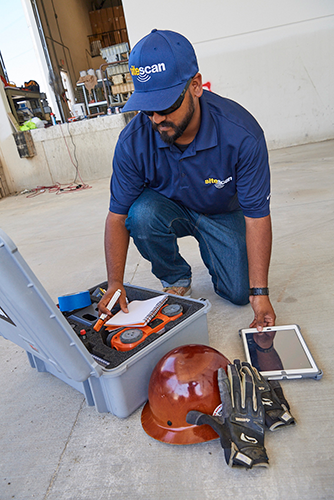RainierGPR Service Areas: Comprehensive Insurance Coverage for Concrete Scanning
RainierGPR Service Areas: Comprehensive Insurance Coverage for Concrete Scanning
Blog Article
Enhancing Task Preparation and Implementation Via Advanced Concrete Scanning Methods
In the world of task planning and precision, implementation and insight are important components that can make the distinction in between success and problems. Advanced concrete scanning techniques have actually emerged as an advanced device set to raise the criteria of task management within the construction sector.
Advantages of Advanced Concrete Scanning Techniques

Improved Accuracy in Task Evaluations
Enhancing task assessments via innovative concrete scanning techniques considerably improves the precision and integrity of building evaluations. By employing cutting-edge scanning technologies such as ground-penetrating radar (GPR) and 3D imaging, job groups can now obtain thorough insights into the problem of concrete frameworks, recognizing prospective flaws or weak points that may not show up to the nude eye. This improved degree of accuracy in job evaluations allows building experts to make even more informed choices pertaining to repair service and maintenance approaches, resulting in boosted overall job end results.
Moreover, the increased precision in job analyses accomplished via innovative concrete scanning methods aids in lessening the danger of unpredicted problems throughout the construction phase. By proactively spotting surprise abnormalities within concrete structures, such as rebar corrosion or spaces, project groups can attend to these issues at an early stage, preventing costly hold-ups and rework later in the project lifecycle. Ultimately, the enhanced accuracy in task assessments facilitated by sophisticated concrete scanning techniques adds to greater performance, cost-effectiveness, and quality in building and construction tasks.
Early Recognition of Architectural Difficulties
Early discovery of structural challenges plays an essential role in ensuring the integrity and safety and security of concrete structures throughout the building procedure. Determining possible concerns at a beginning permits timely treatment, preventing pricey rework, routine delays, and safety hazards. Advanced concrete scanning methods, such as ground-penetrating radar (GPR) and 3D imaging, allow task groups to uncover covert defects, spaces, reinforcement layout inconsistencies, and various other anomalies that might jeopardize the framework's stability.
By applying these methods during the preparation and implementation phases, construction specialists can proactively attend to structural obstacles prior to they intensify into major issues. As an example, discovering inadequate concrete cover over reinforcement bars early on can avoid corrosion and architectural weakening in the lengthy run - RainierGPR Service Areas. Moreover, recognizing variations in concrete thickness or thickness can assist enhance product usage and ensure consistent stamina buildings you can try these out throughout the framework
Ultimately, early identification of structural difficulties through innovative concrete scanning not only boosts the overall high quality and toughness of the construction however also adds to a safer built environment for individuals and occupants.
Enhanced Precaution in Building And Construction
The implementation of robust security methods is important in the construction market to reduce threats and safeguard the wellness of employees and stakeholders. Building and construction sites are inherently dangerous environments, with prospective risks varying from drops and devices breakdowns to structural failings. To boost safety and security procedures, building and construction companies are increasingly adopting technological improvements such as wearable devices that check workers' important signs and detect potential health problems in real-time. Additionally, the use of drones for website surveillance enables normal security evaluations without placing personnel in injury's means. Safety and security training programs have additionally evolved to consist of online reality simulations that supply hands-on experience in handling emergency look at these guys scenarios. Furthermore, the integration of artificial knowledge in security administration systems makes it possible for aggressive identification of possible threats, permitting for prompt interventions. By focusing on security with the incorporation of advanced innovations and comprehensive training programs, building jobs can considerably lower mishaps and produce a safe workplace for all included - RainierGPR Service Areas.
Streamlining Project Monitoring Processes
To optimize operational efficiency and ensure project success in the building industry, a concentrate on streamlining task monitoring processes is vital. By carrying out reliable project monitoring procedures, building jobs can decrease delays, reduce costs, and enhance general productivity. One key facet of streamlining job management is making use of advanced technologies such as Building Details Modeling (BIM) software application, which makes it possible for real-time partnership, clash discovery, and accurate job scheduling. In addition, the adoption of cloud-based task monitoring platforms enables smooth communication amongst staff member, instantaneous access to project data, and the ability to track development in real-time.

Verdict
To conclude, the use of advanced concrete scanning techniques supplies countless advantages for task planning and execution. These methods offer better precision in task assessments, very early recognition of architectural challenges, boosted precaution in construction, and streamlined task administration processes. Incorporating these methods right into project operations can eventually lead to extra successful and effective end results in construction jobs.
Eventually, the improved precision in job evaluations promoted by advanced concrete scanning techniques contributes to greater performance, cost-effectiveness, and quality in building and construction jobs. RainierGPR Service Areas.
To enhance functional effectiveness and make certain job success in the building market, an emphasis on improving project management processes is essential. By executing reliable task management processes, building and construction tasks can decrease delays, minimize expenses, and enhance general performance. By improving job management procedures via innovation combination, clear communication, and data-driven approaches, construction jobs can attain greater performance, cost-effectiveness, and effective end results.
These methods give better precision in task analyses, very early identification of architectural difficulties, improved safety and security measures in construction, and streamlined job management procedures.
Report this page